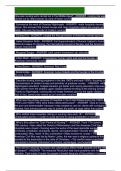EXAM 1 NURS 314 STUDYGUIDE.
How was nursing work carried out in the Middle Ages? - ANSWER nursing role was
carried out by deaconesses by early christian church
Summarize the work of Florence Nightingale - ANSWER made hospitals cleaner
places. She showed that trained nurses and clean hospitals helped sick people get
better. She was the founder of modern nursing.
Dorthea Dix - ANSWER created the first generation of American mental asylums
Isabel Hampton Robb - ANSWER first Superintendent of Nurses/ helped to found
National League for Nursing, the International Council of Nurses, and the American
Nurses Association.
Margaret Sanger - ANSWER birth control movement/ sex educator
Lillian Wald - ANSWER humanitarian/ human rights and was the founder of
American community nursing
Clara Barton - ANSWER American Red Cross
Breckinridge - ANSWER American nurse-midwife and the founder of the Frontier
Nursing Service
Describe nursing training programs in the late 1800's and early 1900's, focusing on
characteristics of student nurses and activities of graduate nurses. - ANSWER with
Nightingale's standard, hospital situation got better and nursing education improved.
even women from the wealthy upper classes started enrolling at the training school.
Thanks to Nightingale, nursing was no longer frowned upon by the upper classes; it
had, in fact, come to be viewed as an honorable vocation.
What was the primary purpose of hospitals in the United States during the 1600's,
1700's and 1800's? Why were these called pesthouses? - ANSWER Used to house
the poor and downtrodden/ because it was created to care for clients with contagious
disease; their primary purpose was to protect the public at large rather than patient
Who staffed these hospitals, taking on nursing roles early 18? - ANSWER
Uneducated women, in order to avoid jail time for doing prostitution or stealing.
Why is this called the "Dark Period of Nursing"? - ANSWER From 17th century -
19th century • Also called the Period of Reformation until the American Civil War •
Hospitals were closed • Nursing were the works of the least desirable people
(criminals, prostitutes, drunkards, slaves, and opportunists) • Nurses were
uneducated, filthy, harsh, ill-fed, overworked • Mass exodus for nurses • The
American Civil War was led by Martin Luther, the war was a religious upheaval that
resulted to the destruction in the unity of Christians. • The conflict swept everything
connected to Roman Catholicism in schools, orphanages, and hospitals
How did the industrial revolution and urbanization affect health hazards and the risk
of disease? - ANSWER The Industrial Revolution had many problems with the
pollution. Coal made it harder for people to breath because of the pollution it caused.
, EXAM 1 NURS 314 STUDYGUIDE.
Disease accounted for many deaths in industrial cities during the Industrial
Revolution. With a chronic lack of hygiene, little knowledge of sanitary care and no
knowledge as to what caused diseases. Diseases such as cholera, typhoid and
typhus could be devastating.
What social reforms were undertaken in the early 1800's to counter disease? -
ANSWER Lead by Florence Nightingale, she campaigned for reforms in nursing and
was a vocal proponent of sanitation practice. Simple sanitary practices, such as
hand washing, were promoted by Nightingale and became commonplace in modern
society.
Describe her work in founding the Nightingale School for Nursing at St. Thomas in
1860. Who did she recruit as nursing students? What was the relationship to the
medical staff? Did graduates take a licensure exam - ANSWER 30 older, plain look,
in experienced and not trained, but they write the letters/ simple method. Nightingale
personally advised on all matters of instruction, admissions supervision, and
discipline. Her involvement extended beyond her professional duties; she often
invited graduates to tea and kept in touch with them long after they had launched
their careers. they have to take license exam
In 1873, in the USA, reformers opened hospitals in large cities and recruited
students to train as nurses. Who were these women? Describe their role as nursing
students in the hospital. What happened to them after they graduated—where did
they work? - ANSWER middle working women students.
Nursing students served as the primary nursing staff for these early hospitals.
Summarize the recommendations of important nursing reports: a. The Future of
Nursing: Leading Change, Advancing Health (IOM, 2011) - ANSWER specifically
calls for interdisciplinary education, decreasing barriers to nurses' scope of practice,
and increasing the educational levels of nurses
Summarize the recommendations of important nursing reports: b. Nursing's Agenda
for Healthcare Reform (ANA, 1991) - ANSWER managed care: is a market
approach based on managed competition as a major strategy to contain healthcare
costs
Summarize the recommendations of important nursing reports: c. To Err is Human
(IOM, 1999) - ANSWER related to faulty systems, process, and conditions that allow
error, rather than individual recklessness
Summarize the recommendations of important nursing reports: d. Goldmark Report
(1922) - ANSWER First significant study of labor market in 20th century.
Recommended basic hospital training as well as school work. Josephine Goldmark
Relate the Nurse of the Future Core Competencies to curriculum in BSN nursing
programs. - ANSWER • Patient-Centered Care
• Professionalism
• Leadership
• Systems-Based Practice
• Informatics and Technology




